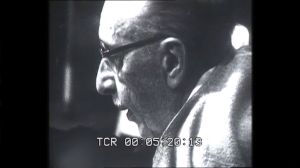
Igor Stravinsky in Venice, 1956
© MARKA Alamy Stock Photo
Discover Igor Stravinsky
The Composer’s Late-Period Work at Musikfest Berlin
When music lovers think of Igor Stravinsky, they often remember the sound and rhythm of “The Fire Bird” or of “The Rite of Spring”. The composer’s late-period works is less well-known and until today, it only makes sporadic appearances in musical life. Equally devoted to the music of the past and open to the musical currents of his time, Stravinsky created works in his later years that are impressive proof of his never-waning creativity. On the occasion of the 50th anniversary of his death, Musikfest Berlin will dedicate this year’s festival edition to this creative period, opening a doorway into Stravinsky’s musical cosmos for its audience.
1
Stravinsky’s First Years in America
Brave New (Sound-)-World
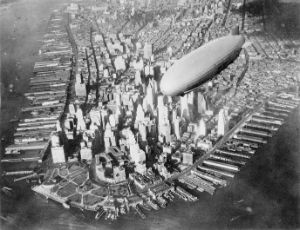
The airship USS Akron over Manhattan, ca. 1931-1933
When Igor Stravinsky arrived in New York on 30 September 1939 – four weeks after the outbreak of the Second World War – he was 57 years old. Five days previously, he had left Europe from Bordeaux on board the passenger steamer S.S. Manhattan, departing for a more or less unknown, uncertain fate. A departure into a new world, but not really a break with the old: The fact that the first two movements of the “Symphony in C” were composed in Paris and the final two movements in Hollywood remains unnoticeable in the work.
Igor Stravinsky as a Dandy
Igor Stravinsky as a dandy – this is how the French painter Jacques Émile Blanche painted him in this gouache from 1916, which was based on a previous oil painting: nonchalant, elegant, dressed in light-coloured trousers and a dark sports jacket, with a white dress handkerchief that harmonised with his light-coloured shirt. Both arms casually at his hips, a walking cane in one hand, his coat draped over the other arm and revealing the green lining. His feet are in black shoes with spats.

Jacques-Émile Blance (1861-1942), Portrait of Igor Stravinsky, 1916, gouache
It had been nearly 30 years since Stravinsky celebrated his first triumph with the ballet “The Fire Bird” on 25 June 1910. His collaboration with Sergei Diaghilev and his legendary Ballets russes had been the lynchpin of his creative work until Diaghilev’s death in 1929 and the company’s subsequent disintegration – founding the composer’s fame chiefly as a composer for ballet and opera. “Petrushka” (1911) and “The Rite of Spring” (1913) were followed by the Russian peasant opera “Les Noces” (1914 – 1917) and the burlesque fable “Renard” (1915/16), the mimodrama “L’Histoire du soldat” (1917) and the neo-classicist “Pulcinella” (1919/20), the opera bouffe “Mavra” (1922) and the archaic opera oratorio “Oedipus Rex” (1926/27) in Latin. None of these works were similar. Russian folklore was juxtaposed with sophisticated sound gossamers á la Debussy, brute rhythms with widely arced melodies, baroque concerti and medieval modality with influences from music hall and jazz.
Life Stages – Stravinsky in Brief
Igor Stravinsky was born in Oranienbaum near Saint Petersburg on 5 June 1882. It was not until he was 20 years old that he started to dedicate himself seriously to composition and study with Nikolai Rimsky-Korsakov. His encounter with Sergei Diaghilev, founder and impresario of Ballets Russes, was to be decisive for his further creative development. In 1910, Stravinsky celebrated his first success with “The Firebird”, a work commissioned by Ballets Russes and written in Paris. The 1911 Paris premiere of “Petrushka”, another piece commissioned by Diaghilev, only increased Stravinsky’s renown. But his international career only began with the 1913 world premiere of the the revolutionary “The Rite of Spring”.
The year 1914 marked the beginning of his lifelong exile, to which he initially felt constrained for professional reasons and later by the First World War and the emergence of the Bolshevist regime in Russia. He lived mainly in Switzerland until 1920, then in France until 1939, and finally in the US from 1939/40.
Beside his concertos, symphonies, chamber music, more ballet scores and operas, he consistently wrote religious works throughout his life. Stravinsky frequently performed as a pianist and a conductor of his own works. He died on 6 April 1971 in New York and was buried on the cemetery island of San Michele in Venice in accordance with his wishes.
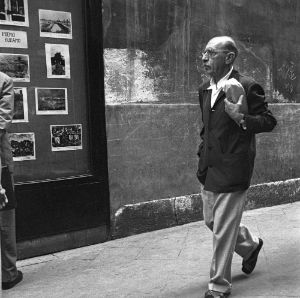
Igor Stravinsky walking in Venice, Italy
© akg / Archivio Cameraphoto Epoche
“He has been called the Picasso among composers. When Igor Stravinsky died 50 years ago at the age of 88, he had created a life’s oeuvre that appears similar to the famous painter’s: full of surprising twists, appropriations and conversions. Confidently leaving a distinctive mark on his time, not afraid of provocation and extravagance, admired and celebrated, carried by an indissoluble joy in musical creation (Plaisir de la creation), as he wrote in his “Poetics of Music”.”
Winrich Hopp – Artistic Director Musikfest Berlin
So it should have come naturally to him to establish himself in the New World – for instance in America’s native musical domains of jazz and film music. Even while still in Paris, Stravinsky had explored jazz in his “Ragtime” for eleven instruments (1918) and the “Piano Rag Music” (1919). But his jazz and big band arrangements of “Tango” (1940/41), the adaptation of “Scherzo á la russe” (1944) for Paul Whiteman’s big band or his collaboration with Woody Herman and the clarinetist Benny Goodman in the “Ebony Concerto” (1945) were to remain the only projects of this kind. And film music did not bring him happiness either. Of course, the use of his “The Rite of Spring”. in Walt Disney’s animated masterpiece “Fantasia” (1940) was excellent ‘material’, but several subsequent film scores failed.
Thus, Stravinsky’s first years in the New World were difficult – also and especially with regards to his financial situation. Accordingly, he busied himself with revisions and new versions of his old European ‘classics”, which he could then re-register with ASCAP – the American pendant of Germany’s GEMA – and gain legal protection for them.
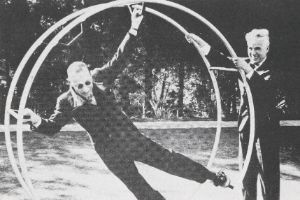
Igor Stravinsky and Charlie Chaplin in Beverly Hills, ca. 1940
© King Vidor
Igor Stravinsky chose Beverly Hills in California as his residence in America. There, he met not only other European emigrants but also American artists from various disciplines, including the film business. The picture shows him with Charlie Chaplin, trying out a gym wheel with evident delight. The photo was taken in Chaplin’s garden by the American director King Vidor.

Igor Stravinsky rehearsing with Woody Herman and his band, ca. 1946
Igor Stravinsky had already been a jazz fan before he moved to America. Works like “L’Histoire du soldat”, for example, are influenced by jazz. Conversely, jazz musicians were fascinated by the vitality in Stravinsky’s music. It did not take long for someone like the great jazz clarinettist Woody Herman and Stravinsky to find each other. For Herman and his band, he wrote the “Ebony Concerto”.

Igor Stravinsky and Charlie Chaplin in Beverly Hills, ca. 1940
© King Vidor
Igor Stravinsky chose Beverly Hills in California as his residence in America. There, he met not only other European emigrants but also American artists from various disciplines, including the film business. The picture shows him with Charlie Chaplin, trying out a gym wheel with evident delight. The photo was taken in Chaplin’s garden by the American director King Vidor.

Igor Stravinsky rehearsing with Woody Herman and his band, ca. 1946
Igor Stravinsky had already been a jazz fan before he moved to America. Works like “L’Histoire du soldat”, for example, are influenced by jazz. Conversely, jazz musicians were fascinated by the vitality in Stravinsky’s music. It did not take long for someone like the great jazz clarinettist Woody Herman and Stravinsky to find each other. For Herman and his band, he wrote the “Ebony Concerto”.
Programme of the Musikfest Berlin
Concerts with works from the years 1910 - 1922
2
The Late-Period Work
New Avenues
If you review Igor Stravinsky‘s catalogue of works, which contains around 120 compositions, you will find that 18 works were created before 1910 in Russia, 62 during his years in France and Switzerland (between 1910 and 1939) and 41 after his emigration to the United States, where he became a citizen in 1945. But this final third of his oeuvre appears to have been largely disregarded by European music history. Aside from very few exceptions, public perception of this late-period work has been appallingly meagre, both in concerts and recordings. Here are some numbers to illustrate this: While the jpc-catalogue, for example, lists 303 hits for “Rite”, the twelve-tone ballet “Agon”, which he wrote for the former Diaghilev-choreographer George Balanchine and his New York City Ballet between 1953 and 1957, had no more than 20. The “Symphony of Psalms” is cited 105 times, “Canticum Sacrum” only four, “Threni” five and “Requiem Canticles” twelve times (results of 10 June 2021).
“During the 1950s, the composer Igor Stravinsky effected a transformation of a kind that one would not have expected of him, known as everybody’s darling, and whose music seemed to contain an opposing sound to that of his dodecaphonic contemporaries. He occupies himself with the music of Anton Webern and Arnold Schönberg, he even pledges himself to their music by adopting their serial thinking and he shows a vivid interest in the work of Pierre Boulez and Karlheinz Stockhausen, who were young composers at the time. The antagonistic world view of neo-classicist music on this side and the music of the dodecaphonists on the other, mainly conjured up by critics, collapses in on itself because the protagonist Stravinsky refuses to be instrumentalised. It is not that he changed sides. He quite simply did not care. He only followed his own ear.”
Winrich Hopp – Artistic Director Musikfest Berlin
The sources of his inspiration were manifold. Stimulated by Diaghilev, he processed pieces of music and singing by Giovanni Battista Pergolesi. In his “Concerto en ré” for violin and orchestra, too, which he had written 15 years previously for the violinist Samuel Dushkin, he drew on musical traditions and assimilated them to his notions. He studied baroque forms of music, such as the Concerto grosso, familiar to us from Bach’s “Brandenburg Concertos”.
Many were surprised when he turned to dodecaphony – even if the rules he applied were quite different from those of Arnold Schönberg and his school. What the 70-year-old Stravinsky carried out from the early 1950s, in works like the ballet score “Agon” or his “Movements” for piano and orchestra, was in fact nothing but a continuation of his specific structural thinking, on which he had already experimented as early as 1920 in his “Symphonies d’instruments à vent”. The reduction and concentration of the material that can be observed in this work as well as in the “Piano Concerto with Wind Instruments” that he composed three years later anticipated the specific, often wind-dominated sound-colour disposition that was to be found in many of Stravinsky’s late-period works.
The journey from the colour-replete orchestra opulence of the early Diaghilev ballets, shaped by his teacher Nikolai Rimsky-Korsakov, to the sparse, at times almost brittle orchestration of many of his works from the American years is not unlike the journey of his friend Claude Debussy. The strict order that resulted from it is not in any way inferior to the principles of order applied in serial music, even if it may follow a quite different set of rules.
“I saw Stravinsky recently … He said “my Fire Bird, my Sacre”, just like a child might say “my top, my hoop”. And that is precisely what he is: a spoilt child who sometimes sticks his finger up the nose of music. He is a wild young man who wears excitingly brash ties and kisses ladies’ hands while stepping on their feet. He will be unbearable once he is old… but at this moment he is extraordinary!”
Claude Debussy in a letter to Robert Godet, 4 January 1916
Programme of the Musikfest Berlin
Concerts with works from the 1950s
3
Sacred Music
The Moment of Recognition
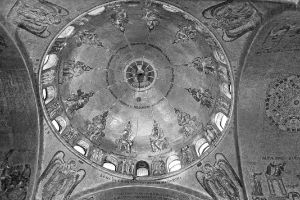
Dennis Jarvis, Venice, San Marco, Pentecost Mosaic
CC BY-SA 2.0
One of the many constant’s in Stravinsky’s creative work on both sides of the Atlantic was his religiousness. Without being overly religious, he had been raised in the Russian-Orthodox faith, but broke with the church in 1910. In 1926, however, he visited the grave of St Anthony of Padua. He was in a deep, personal crisis, torn between the relationship with his wife Katya and his affair with the young Vera Soudeikina, whom he was to marry in 1940, after Katya’s death. Searching for inner peace, Stravinsky recounts, “I asked for a sign to tell me when and if my prayers would be heard. And they were heard, and because of this sign I do not hesitate to call this moment of recognition the most truthful of my life.” His first works of church music were composed not longer afterwards. While these were still strictly liturgical, his “Symphony of Psalms”, commissioned by Sergei Koussevitzky in 1929/30 for the 50th anniversary of the Boston Symphony Orchestra, introduced a mixed form which cannot truly be categorised as church music in the strictest sense, but is open to performances in secular contexts.
It is difficult to tell the depth of Stravinsky’s religiousness. In any case, it encompassed Catholic elements as well as Anglican, Russian-Orthodox or Jewish traditions and it was in some ways inspired by almost child-like notions. In order to write church music, he once said in his conversations with Robert Craft, “it is necessary to not just believe in ‘symbolic figures’, but also in the person of god, the person of the devil and in the miracles of the church.”
4
Venedig
Igor Stravinsky and Venice
Over the last two decades of his life – after the world premiere of “The Rake’s Progress” at the Teatro La Fenice (on 11 September 1951) – Stravinsky found a kind of mental and spiritual home in Venice. He considered Venice to be the mirror city to St Petersburg, and not only because of its bridges, canals, domes and palaces. Stravinsky also felt at home in Venice’s musical culture and tradition. Especially, since the cultural roots that had connected Venice with the eastern Mediterranean for centuries were familiar to him from his youth.

Paolo Monti, Piazza di San Marco, 1977
© https://commons.wikimedia.org/wiki/File:Paolo_Monti_- _Servizio_fotografico_ -_BEIC_6342969.jpg, https://creativecommons.org/licenses/by-sa/4.0/legalcode
Several of his late church music works were created for this city: “Canticum Sacrum” was commissioned by the Serenissima and dedicated to her patron, the evangelist Mark. It was performed inside St Mark’s Basilica and conducted by the composer himself. His most elaborate sacred composition, “Threni”, was created for the oratory hall of the Scuola Grande di San Rocco, decorated with frescos by Tintoretto. The “Requiem Canticles” (1965/66), in their gossamer of the text of the Latin requiem mass and a severe twelve-tone technique, conclude the process of his compositional development. They were heard in 1971, at his obsequies in the church San Giovanni e Paolo in Venice, before he was buried in the Russian portion of the cemetery island of San Michele.
– Author: Michael Stegemann
Programme of the Musikfest Berlin
Concerts with Stravinsky's sacred music
5
Outro
A Tribute to Stravinsky
In a short film, Leonard Bernstein pays a very personal tribute to Igor Stravinsky.
